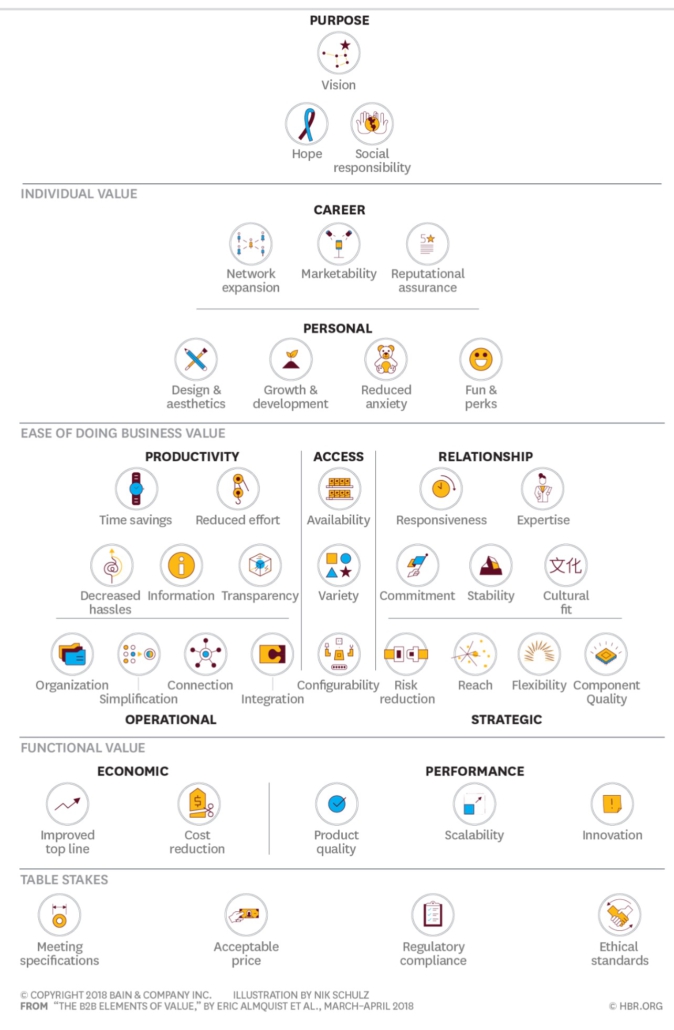These values count in B2B sales: 40 things that really matter to your customers
This article takes a look at the research and explains how it can be used to better understand the subjective decision criteria of your customers. Based on this, you can then form a value proposition that meets the deepest needs of your customers.
Buying decisions of B2B customers are more similar to those of private customers (B2C) than it might seem at first glance. It is not only objective criteria that count, but also subjective factors. These include whether the brand matches the positioning of the own company or whether the design and features are attractive.
The fact is that B2B providers have to optimise their prices, fulfill performance specifications and comply with a wide variety of regulations. In addition, they are evaluated by purchasing according to strict specifications. In this way, companies ensure that only rational and quantifiable criteria are considered in price-performance analyses.
As with private buyers, however, subjective and sometimes very personal views are also incorporated into the procurement process for corporate customers. It is therefore important to know the entire range of rational and emotional factors that are decisive for the purchasing process. After all, the customer should perceive the products and services of his supplier as unique and decide accordingly.
How Bain’s B2B value pyramid provides an advantage for your sales team
What do your customers appreciate most about your offer? Low costs? Quality? Innovative technology?
Many B2B sales teams focus their value proposition on product or service features and differentiate it with statements such as “the most advanced on the market” or “the lowest cost per unit in its class”.
The 2018 study published by Bain & Company in the Harvard Business Review shows that the more subjective value elements are what really drives B2B buyers.
To illustrate this, Eric Almquist of Bain created a pyramid with 40 different types of values that B2B products and services can offer – the diagram is progressive, ranging from objective elements at the bottom to the most subjective at the top of the pyramid.
Bain’s EVP – the value pyramid of B2B customers
The Elements of Value Pyramid (EVP) consists of five levels. At the bottom of the pyramid are basic objective values; while towards the top the values become more and more subjective and emotional.

Here is an interactive version of the value pyramid.
Level One (lower): Basic Requirements / “Table Stakes” 1)
This level includes key functional elements such as costs, specifications and regulatory compliance.
Level two: Functional values
This level includes economic and performance factors such as ROI and scalability. These values have traditionally been the most important sales arguments.
Level three: Easy processing
This level includes a set of values related to productivity, access, relationships, and operational and strategic factors. Some other subjective elements begin to emerge at this level – for example, cultural fit and commitment.
Level four: Individual values
Until now, most of the pyramid’s values were business-related and therefore objective. But as soon as we reach level two, they become much more subjective. The two areas on this level are the personal benefit and the career of the individual.
Level five (top): Inspiring values
The top level consists of only three, but deeply personal values and only one category called “purpose”. It includes vision, hope and social responsibility.
Emotional, subjective values
While the elements at the bottom of the pyramid are important business considerations, the emotional values at the top are also an important factor in the purchase decision. Fear, for example, often plays a role for those customers who are responsible for purchases that involve significant sums of money or affect a number of colleagues.
As an example, the authors cite a hypothetical US telecommunications provider that recently upgraded its fiber optic video service. He chose a China-based company that offered a low price. However, after installation, there were regular outages and technical support was available on another continent. The impact of this negative experience illustrates the importance of values throughout the pyramid. Due to poor implementation, the China-based company was unable to maintain good relationships (level 3).
The company eventually switched suppliers, but not without losing a good reputation with customers (level 4). Ultimately, the buyer was ultimately responsible, which had an impact on levels 4 and 5.
A tried and tested approach
Many companies base their value proposition on functional elements from the lower half of the pyramid.
However, Bain wanted to understand how adherence to elements from the different levels of the value pyramid would affect business performance – especially customer loyalty. Bain surveyed more than 2,300 business decision-makers in the IT infrastructure and insurance industries.
Information was collected on the decision-makers’ perception of how B2B sellers behaved above the basic requirements in the 36 elements of the value pyramid – the “table stakes” were deliberately excluded from the analysis because they are more likely to be prerequisites for business activities and not differentiators.
Excellency was defined by the fact that at least six or more elements were rated high (very good) by at least 2/3 of the decision makers. This is then compared with the company’s Net Promoter Scores (NPS®) 2) to see how the two are related.
Bain’s analysis showed that excellence in several elements has a strong influence on business performance. The study showed that customers in the IT industry are more likely to repeatedly buy from those who have excelled at multiple elements: 43% of respondents said they would be more likely to buy from them again, compared to 21% who have not excelled at any elements.
The analysis also revealed the most important elements.
Respondents in the IT industry rated cost reduction as their most important value. However, when Bain calculated how much each element affects NPS, product, quality, expertise, and responsiveness proved to be the strongest predictive attributes for customer retention.
Seven of the ten most important elements for this industry are at the “Ease of doing business” level. This means that IT infrastructure providers would do well to focus on these areas to improve business performance.
Improving your value proposition
How can we as B2B sellers put the pyramid and research into practice?
First step: Evaluate your value
Check your promise of performance against the pyramid. Identify where your offer stands in terms of subjective and objective values. The most important part of this is to find out what your customers think. You may not have the resources to conduct a comprehensive survey of them all, but you should be able to conduct a few interviews and gather what information you can get during conversations with customers – anything to gain insight into their feelings.
Once you have feedback, compare it to the pyramid – have you received positive feedback at the top or bottom of the pyramid? Are there elements you could focus on elsewhere that would improve your value proposition?
Now take a look at what your marketing and sales team is currently focusing on. How does this compare to what you have found? What needs to change to better communicate your value and sell your business?
Step Two: Use data
Data is critical for understanding which values are most important to your customers. However, these values can change from day to day, depending on how the business is going.
By using real-time data on metrics such as financial stability, growth and new leaders, you gain insight into how the business is likely to respond (the goal) and how the people in the business think about it (the subjective).
Step Three: Focus on your value proposition
Now that you understand your value and understand the needs and concerns of your customers, you can precisely tailor your offering. Elements such as less fear, reputation insurance and hope could play their part when selling to a company facing difficult times.
For example, if you are selling short-term working capital loans by focusing on interest rates and speed, then you should also consider emphasising elements such as reduced anxiety and hope.
RÉSUMÉ
In this article, we showed how with a little research, a little self-reflection and quick access to powerful real-time data, you can improve your business performance.
Eric Almquist found that those companies that scored highly on more than six elements had a 60% higher NPS (Net Promoter Score) than those without high scores.
This means that the value pyramid of B2B customers is something that no company should ignore.
1 ) In business life, the term “table stakes”, which comes from poker, also refers to the basic requirements for entering a market or a business relationship.
2 ) The NPS® is a globally standardised and easy-to-use method developed by the management consultancy Bain & Company for measuring the willingness to recommend a brand, a product or a service and thus serves to indirectly measure customer satisfaction.
This is done with one central question: “How likely is it that you would recommend our [Company X] to a friend or colleague?
Customers are asked to rate their response on a scale from 0 to 10. This scale is divided into three categories: “Detractors”, “Indifferents” and “Promoters”.
0 – 6: Detractors
7 – 8: Indifferent duck
9 – 10: Promoter
Eric Almquist is a partner in the Boston office of Bain & Company. He is a global leader in the Advanced Analytics Practice and a member of the global Customer Strategy & Marketing team at Bain
This article has been adapted. The original article appeared in the Harvard Business Review: “The B2B Elements of Value” by Eric Almquist, Jamie Cleghorn, Lori Sherer, April 2018
Here yo can find a video with further clarification
I SUPPORT YOU ON THE WAY TO YOUR SUCCESS
I am a strategist, an innovator, an unconventional thinker, a mover and shaker and therefore I do the right things sooner and better.
And with pleasure also for you.
Together we can discover new market opportunities, steer product branding into the right direction, understand your customers better – and stand out from the competition with tailor-made products for your target group. All this leads to more customer satisfaction, greater customer lifetime value and more sales potential.
Can you afford not to go for it?






